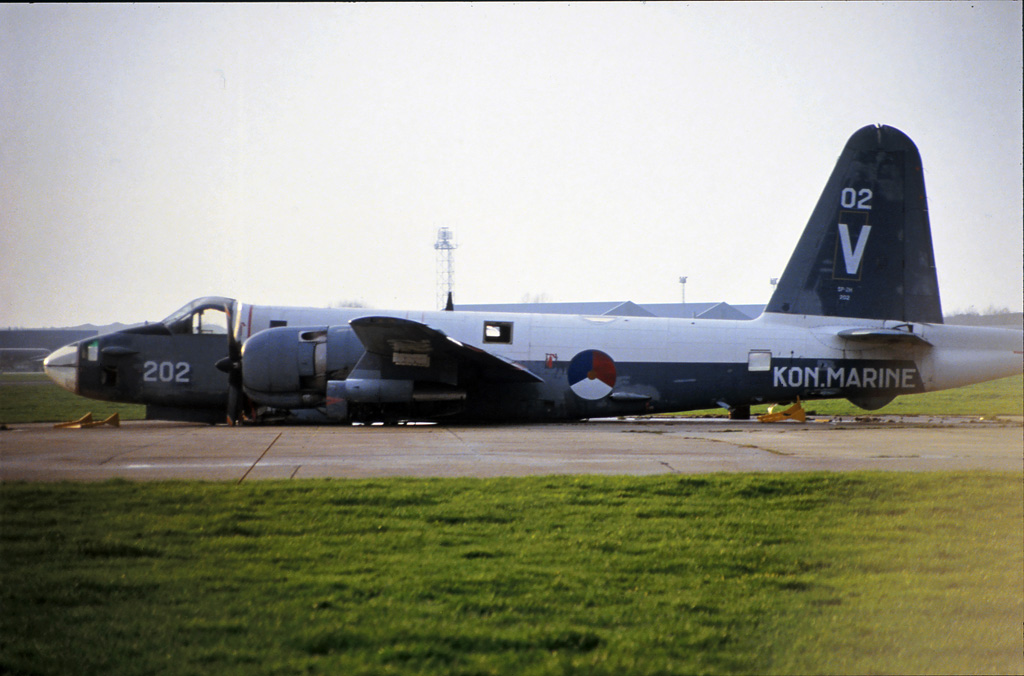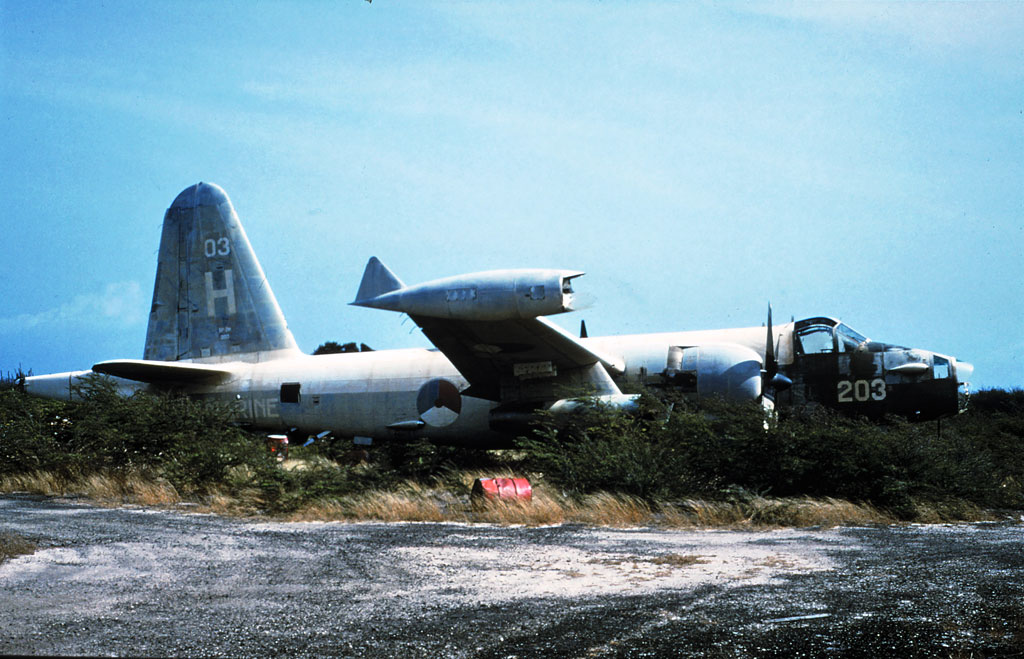|
|
| |
|
| Service
history of the Lockheed Neptune with the MLD
The P2V-5 was the most
numerous Neptune variant produced and would serve as the basis for the
largest number of sub-type modifications developed of any of the
Neptune series.
On the 21 off August 1961, it was decided by the Dutch Ministry of
Defence that the Royal Netherlands Navy (MLD , Marine Luchtvaart
Dienst) was to acquire 15 Lockheed Neptune air frames type P2V-7B.
The reason for this acquisition was a large conflict with Indonesia
over the Dutch colony Papua New Guinea. To strengthen the presence of
the Dutch armed Forces in the region, the choice fell on the Lockheed
Neptune
Delivery to the Royal
Netherlands Navy (MLD)
Built by Lockheed at Burbank as a P2V-7B, the P2V-7 being the last
Neptune variant produced. The -7B was specific to the Dutch and
initially had a solid nose mounting four 20mm cannon, plus ventral nose
radar radome, underwing booster jets, five bomb racks under each wing
and extended MAD tail
The Fifteen P2V-7Bs (serials 200 to 214) were delivered to No. 321
Squadron between September 1961 and February 1962. Eventually eleven
aircraft were flown from Lockheed Burbank to Naval Air station Biak in
Netherlands New Guinea. The chosen route was: Burbank-NAS Alameda-NAS
barbers Point-NAF Kwajalein to Biak, a flight from more than 6000
miles..
Four Neptune’s (Serial 209 to 210) were flown directly from the factory
to the Netherlands for crew training and evaluation.

Operational history
In August
1962, the conflict came to an end. In that same year the Neptune’s flew
back from NAS Biak via Tan-Son-Nhut-Katunayake-Karachi-Basra-Athens and
finally to NAS Valkenburg. Only ten aircraft were to return. Neptune
registration number 200, crashed on the 11th of May 1962 at the airport
of Mokmer, after fire in the starboard jet-engine. On landing, it lost
all hydraulic pressure and ended in a ditch and was written off.
After the
return to the Netherlands, the strength of the Neptune fleet was
fourteen aircraft. All were posted to the 320 squadron at NAS
Valkenburg. Joining the other P2V-7Bs of 320 squadron as replacements
for Grumman Tracker aircraft.
On the 23
of January 1965, Neptune 212 crashed in the North Sea. In the same year
it was decided to increase the squadron with four ex- French Navy
Neptune aircraft. Ad they came available with the introduction of the
Atlantic in the French navy, these were numbered 215 to 218.
The
Neptune’s were given a major up-date programme by Aviolanda, at
Woensdrecht. The up-date included rebuilding of the antisubmarine
systems with improved ASW/ECM equipment and removal of the 20mm nose
cannon, and their replacement with a clear nose cone. Becoming a P2V-7S
or SP-2H after the up-date.
The
Neptune's were gradually withdrawn from service from 1969. From the
1970s Dutch Neptune’s carried an overall dark sea grey colour scheme,
with search and rescue and pollution surveillance amongst their tasks.
From 1974
onwards three Neptune’s were based at the Hato airbase at Curacao
in the Netherlands Antilles north of Venezuela in the Caribbean sea,
mainly for SAR duties. Joining other aircraft that flew in the
Caribbean on search missions in support of the US Coast Guard Station
at Puerto Rico and others flew medium-range maritime patrols.
|
| Squadrons
equipped with the SP-2H Neptune |
|
320 Squadron
After the war 320 squadron was temporarily disbanded on May 1, 1946. On
March 22, 1949 it was re-activated again at NAS Valkenburg. In the
first post war years 320s main task was Search and Rescue, for this
several aircraft types were used.
The squadron proved very effective during the 1953 flooding of the
Dutch province of Zeeland. From that year on 320 concentrated on
maritime patrol tasks. For this purpose the Harpoons were replaced by
long range aircraft, the Lockheed P2V-5, or SP-2E. These were better
equipped for anti submarine warfare. In 1960 the faithful Neptune was,
in its turn, replaced by the Grumman S-2A Tracker.
After the disbandment of the Dutch New Guinea based 321 Squadron, their
P2V-7, or SP-2H Neptune's, went to 320 Squadron to replace the
Trackers. When the Neptune's reached the end of their service life, a
replacement was found in 1982, in the form of the Lockheed P-3C Orion.
The end of the Cold War meant that there was no longer any direct
soviet submarine threat, and the political decision was made to cease
all fixed wing aircraft operations. The unit was disbanded on 14
January 2005 and its Orion's sold to Germany and Portugal.
|
|
321 Squadron
This squadron was founded during the war as a part of the British Fleet
Air Arm. The AVRO Anson was used by the Dutch personnel, usually people
who had fled for the German occupation of their country. The tasks of
321 squadron were coastal patrol and anti-submarine warfare. Due to
lack of personnel the squadron had to be temporarily disbanded on
January 18, 1941.
As many airmen had fled the Japanese occupied Dutch East Indies, and
had gathered in Ceylon, the squadron was re-activated at Trincomalee in
March 1942. With Catalina flying boats and amphibians anti-submarine
missions were flown, also during detachments in Port Elisabeth and
Aden. From 1944 the Catalina's were supplemented by Consolidated B-24H
Liberators.
After VJ day 321 squadron dropped supplies for the thousands of
internees in the POW camps in the Dutch East Indies. Later the squadron
provided aerial reconnaissance and transport for the Government. For
this task a number of Dakotas were used in addition to the Catalina's.
After the independence of Indonesia the squadron moved to Dutch New
Guinea, at Biak air base. During the hostilities in New Guinea, 321s
Neptune's were operated in anti shipping missions. On December 28, 1962
the squadron was disbanded and its SP-2Hs went to Holland to serve
there as the new nucleus for 320 Squadron.
In 1969 after the procurement of nine Brequet SP-13a Atlantic's was
activated again. During its period whit the SP-13A Atlantic the
squadron lost three aircraft due to engine fire and problems with the
rudder. The last was also the reason for the early retirement of the
SP-13A Atlantic in 1984. From there the squadron transited to the
Lockheed P-3 Orion. First in the active role and from 1993 in the
training role after the disbandment of VAQ2 until the end of the
Lockheed P-3 service with the MLD in 2005 at witch point the squadron
was disbanded.
|
|
Vliegtuigsquadron 2
Vliegtuigsquadron 2 was established in 1949 at NAS Valkenburg and
received Fairey Firefly's. The tasks for the squadron were Convoy
protection, reconnaissance and anti-submarine warfare, which they
performed together with sister squadron Vliegtuigsquadron 4,
alternating their deployments. At sea they operated from HNLMS Karel
Doorman, the aircraft carrier of the Royal Netherlands Navy, and at
land they operated from their home base NAS Valkenburg.
In 1954 the Fireflys were replaced by Grumman TBM Avengers. The
squadron was temporarily disbanded in 1961, to become active again at
the end of 1962, this time with the Grumman S-2 Tracker. When the Royal
Netherlands Navy decided to retire the ageing carrier HNLMS Karel
Doorman in 1968, the squadron was disbanded again.
For over two years the squadron was inactive, but it was reactivated
again in 1970 as a training unit, to keep the readiness and training of
the flight crews at the highest level. The first courses were performed
for Atlantic crews and later the Neptune crews were also trained. The
squadron did not have aircraft of their own and loaned these from 320
Squadron and 321 Squadron. From 1981 onwards, the squadron trained
flight crews for the P-3 Orion until its disbandment.
.
|
|
End of the line
|
End of the line
|
 |
 |
| |
320 Squadron retired its last seven Neptune’s in March 1982 as they
were being replaced by the Lockheed Orion. For thirty years, this
beautiful aircraft did sterling service with the MLD. Taking part in
many military exercises and patrolling the oceans in the cold war
period
Of the 19 Neptune's delivered two were destroyed in accidents and from
the remaining aircraft four were saved from the chopper.
A interesting one is 210 this Lockheed P-2 Neptune was used as an
instructional airframe and was hardly ever taken out of the hangar.
Former Royal Netherlands Navy (Marine Luchtvaart Dienst-MLD) 210/V, it
was donated to KLM in December 1983 for use as an instructional
airframe and was resprayed in KLM c/s during 1985. It is now on display
at the "Aviodrome" in Lelystad in its old cs.
|
|
| 200 |
|
|
|
|
|
|
Crashed at Biak |
|
| 201 |
|
|
|
|
Preserved |
|
At MLM Soesterberg |
|
| 202 |
|
|
|
|
|
|
demolished |
|
| 203 |
|
|
|
|
Dumped |
|
Dumped at Hato |
|
| 204 |
|
|
|
|
Preserved |
|
At Cosford UK |
|
| 205 |
|
|
|
|
|
|
demolished |
|
| 206 |
|
|
|
|
|
|
demolished |
|
| 207 |
|
|
|
|
|
|
demolished, Cockpit at de Kooy |
|
| 208 |
|
|
|
|
|
|
demolished |
|
| 209 |
|
|
|
|
|
|
demolished |
|
| 210 |
|
|
|
|
Preserved |
|
First instructional with KLM, now at Aviodrome |
|
| 211 |
|
|
|
|
|
|
demolished |
|
| 212 |
|
|
|
|
|
|
Crashed |
|
| 213 |
|
|
|
|
|
|
demolished |
|
| 214 |
|
|
|
|
|
|
demolished |
|
| 215 |
|
|
|
ex 144691 FN |
|
|
demolished |
|
| 216 |
|
|
|
ex 144692 FN |
Preserved |
|
gate guard at NAS de Kooy |
|
| 217 |
|
|
|
ex 146434 FN |
|
|
demolished |
|
| 218 |
|
|
|
ex 146438 FN |
|
|
demolished, cockpit at MLM Soesterberg |
|
| |
|
|
|
|
|
|
|
|
|
 |
|
|